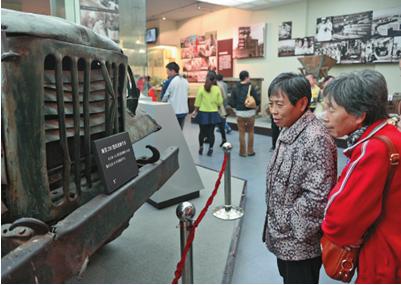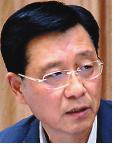 |
|
Tourists admire an old car at the XPCC Army Reclamation Museum in Shihezi, the Xinjiang Uygur autonomous region, on Saturday. ZHAO GE/XINHUA |
The Xinjiang Production and Construction Corps is altering its focus from frontier defense to maintaining social stability as China builds good relations with its neighbors to the west, according to Cheng Jiazhu, deputy commander of the corps, which is marking its 60th anniversary.
Founded in 1954, the corps took on the mission of guarding border areas. Now, it has 176 regiments in 14 divisions scattered throughout Xinjiang's 14 prefectures and cities.
It is a special social organization that handles its own administrative and judicial affairs within the reclamation areas under its administration.
Members even grow much of their own food on farms they manage.
Their role is filled in accordance with the laws and regulations of the State and the Xinjiang Uygur autonomous region, with economic planning directly supervised under the dual authority of the central government and the region.
 |
|
Cheng Jiazhu, deputy commander of the Xinjiang Production and Construction Corps. CHINA DAILY |
"It was to fulfill the mission of consolidating border defense, while avoiding commingling resources with locals," he said.
Combining the functions of production, administration and defense, the corps has made indelible contributions to the development of Xinjiang by promoting unity among ethnic groups, maintaining social stability and strengthening the national border defense, according to a white paper released on Sunday by the Information Office of the State Council.
In 1962, as a result of political tensions in the region, some local residents in Xinjiang's Ili and Tacheng prefectures crossed the frontier.
Under State orders, the corps dispatched more than 17,000 officials and workers to maintain public order and tend the farmland and livestock of those who had fled.
The corps quickly set up a regimental belt of farms ranging from 10 to 30 kilometers in breadth along the more than 2,000-kilometer boundaries of Ili, Tacheng, Altay and Hami prefectures and Bortala Mongol autonomous prefecture. They played a crucial role in maintaining stability in Xinjiang, safeguarding national border security and improving China's strategic position, according to the white paper.
The corps, while charged with guarding a 2,019-kilometer-long border segment, is not a formal military organization but is usually regarded as a semi-military force, usually working as farmers but able to fight as soldiers if needed, Cheng said.
"It also solved the food supply problem," he said. "The production mode in Xinjiang during that period was backward."
While inspecting Xinjiang in April, President Xi Jinping visited XPCC's 6th Division. He said more effort is needed to build the corps into a stabilizer for the country's border areas, a melting pot that integrates various ethnic groups, so it can establish a model region showcasing advanced productivity and culture.
Nowadays, the task of defending the frontier is giving way to an emphasis on maintaining stability, Cheng said. The corps aims to build a qualified militia force to help fight terrorism in Xinjiang.
Over the past six decades, the corps has made remarkable achievements in social and economic development, he said.
"Talented people with passion and dreams were attracted to the region, even though the area was barren," Cheng said.
The corps' GDP in 2013 was 150 billion yuan ($24.4 billion), 218 times what it was in 1954, according to figures released recently by the corps' development and reform committee.
